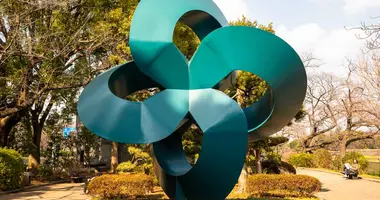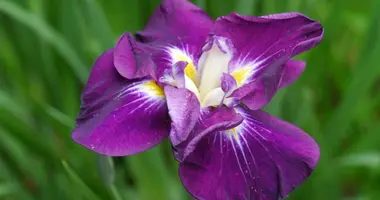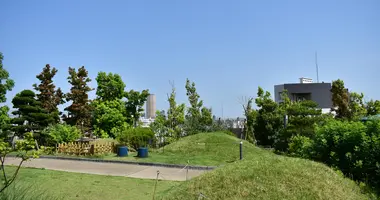Hama-Rikyu Gardens, Tokyo 浜離宮恩賜庭園
- Published on : 16/11/2020
- by : SR
- Youtube
Located in the Shiodome district these beautiful gardens, with its 25 hectares, are a retreat from the city’s hustle and bustle.
Hama-Rikyu Onshi Teien Garden
Hama Rikyu Garden (or "Hama Detached Palace Gardens") is a beautiful and historical tract of parkland near the Shiodome district, and beside the Sumida River, where that river enters Tokyo Bay. The garden is moated, has tidal duck ponds, and visitors can enjoy charming floral and sylvan scenery.
Hamarikyu Garden also contains a ferry landing for Tokyo pleasure cruises on the river and in Tokyo Bay.
Hama Rikyu Gardens is a short walk from Kyu-Shiba Rikyu Garden just a little to the south-west, near Hamamatsucho station. Both gardens can easily be seen in half a day.
History
The site of the garden was originally a tidal duck hunting ground. In 1654, Matsudaira Tsunashige, feudal lord of the Kofu domain, reclaimed part of the tidal ponds to build an urban family villa. The ponds were elaborated on and continued to be used for duck hunting (with nets). They are now a sanctuary within Tokyo for a number of wild species of birds and fish.
The founder Tsunashige's son, Ienobu, later became the sixth Shogun of Japan, and the property became that of the ruling Tokugawa family. The Tokugawa elite could access the garden by boat and the remains of a landing stage are still visible at Shogun O-agariba not far from the present day Water Bus pier.
Shogun Ienobu later renovated the gardens and renamed them "Hama Goden" (Beach Palace). Successive Shoguns made a number of innovations, and the gardens reached their final form under the eleventh Shogun, Ienari.
As with Kyu-Shiba Rikyu Gardens, the property passed to the Imperial Family after the Meiji Restoration of 1868. It was then that it became the Hama-rikyu Onshi Teien, or Hama Detached Palace.
Hama Rikyu was badly damaged by the Great Kanto Earthquake of 1923 and then in the Second World War, and was finally taken over by Tokyo city and opened to the public in 1946. It was officially named a site of great cultural and historical value in 1952.
Layout
Hama-rikyu is a large skewed square (in north-south terms, a diamond). The south-eastern side flanks the Sumida River, where the river meets Tokyo Bay. Its 25 hectares (62 acres) contain a lot to wander through.
To enter the garden, whether at its north-west Naka-no-gomon ("Inner Gate") or its main northern Otemon ("Main Gate"), you cross a bridge over the moat that runs along its NE and SE sides. (If you have baggage, you can leave it at the Garden Administration Office / Visitor Center at the Otemon Gate.)
The first thing you will see upon entering the Otemon gate is the 300 year pine on your left. This sprawling tree, said to have been planted by Shogun Ienobu when he renovated the gardens, is propped up on frames and meticulously tended to.
Just beyond it, over a bridge over the Inner Moat, are the Flower Field and Peony Garden. Just beyond them are the Inabu Shrine and the Plum Grove. And just past the Plum Grove at the eastern tip of the gardens is the Tokyo Bay Waterbus pier.
Between the Otemon and Naka-no-mon gates is the site of what was the Enryokan reception lodge. It was here that the Imperial family used to receive guests.
The Enryokan is said to be the first ever Western-style stone building built in Japan. Ulysses S. Grant, the 18th President of the United States (1869-1877), stayed here for two months.
South of the Enryokan site and of the Naka-no-mon gate is a wild grassy field, and just south of that is one of the duck ponds, the Shinsen-za kamoba, the view from the outside purposely restricted to keep the ducks unaware.
Here, as elsewhere throughout the gardens, are what from afar look something like burial mounds, but are actually feeding posts, or blinds, for the ducks - again, designed to disguise the presence of humans. The construction here dates from 1791.
Immediately to the east of Shinsen-za kamoba duck pond is the huge Shioiri-no-ike ("Incoming Tide Pond"), Tokyo's sole remaining saltwater pond. A sluice gate regulates the water level with the rise and fall of the tides. On its northern bank is a wisteria trellis and a small store.
Shioiri-no-ike pond features an island, Nakajima, with a tea house, Nakajima no Ochaya, first built in 1707, accessible over long wooden footbridges. Sets featuring a bowl of green tea and a Japanese confection are served here starting from 520 yen.
Two other ponds, Koshin-do Kamoba (the first duck pond, constructed in 1778) and Yokobori extend north-east of Shioiri-no-ike.
The flora has something to offer whatever the season, the greatest variety on display being in autumn thanks to the numerous trees that color. The garden is also known for its spring azaleas and cherry blossoms, summer irises, and winter apricots and narcissi.
Address, timetable & access
Hama-Rikyu Gardens
Address
1-1 Hama-rikyu Teien, Chuo-ku
104-0046
Japan
Phone
+81 (0)3 3541 0200Timetable
Open 9 a.m. to 5 p.m. (last entry at 4.30 p.m.)Open every day - except from December 29 to January 1.Price
300 yen. Free for elementary school age and younger.Website
https://www.tokyo-park.or.jp/park/format/index028.html































